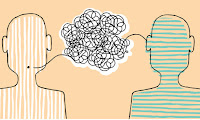Communication
Introduction to Communication
Communication is a process of social interaction, in which someone affects, intentionally or unintentionally, the thoughts and feelings of another person to strengthen the relationship between children and educators, and reach any common understanding or assistance.
Communication Components:
1. The sender: is the carrier of the idea, information, direction, or otherwise to a person or a group of people with the aim of provoking certain behavior to them.
2. The recipient: is the receiver of the message which does not occur without the response of the communication process and in order to stimulate in the child a message of behavior or motive or trend may be negative or positive. His duty is to understand the message and to decode it.
3. Message: A collection of words and texts written by the sender containing the information, thoughts, feelings, and tendencies of the person that sends the recipient (the child).
Types of Communication:
Thhe communication is divided into several types:
First: according to the means:
1. Oral communication: based on the use of direct spoken words or audio recordings, such as a telephone and a radio. It is one of the oldest and most effective methods of communication in effort and time.
2. Written communication: which depends on written words such as (books, stories of children written), so that effort is made in the preparation of the letter and writing.
3. Configurable communication: It is used for graphics, animation, and forms for transmitting information.
4. Non-verbal communication: A communication that depends on the gestures (the body language) and movements of the body.
5. A compound communication: A communication that is used in several ways together, verbal and nonverbal at the same time.
Second: According to the participating parties
1. Self-communication
2. Personal Communication (Individual)
3. Collective communication
4. Mass communication
Communication Disabilities in the Classroom:
1. There is incomplete planning for the communication process.
2. The sender is unable to express the idea that he intends to convey.
3. weak listening by the recipent
4. frequent jamming
5. There is no choice of a suitable communication method with children.
Communication Skills: (Communicating with children)
1. Verbal communication skills are listening, speaking, reading, and writing.
2. Non-verbal communication skills are seeing and physical gestures.
The process of listening to children includes three steps:
1. Receive audio content and ignore noise.
2. Attention to audio content and concentrate on what the speaker says
3. Interpretation and interaction of audio content according to the individual differences of children.
There is a difference between hearing and hearing in that listening corresponds to listening and understanding and discussion, as hearing does not, the individual may hear a sensation or movement outside and do not pay attention to it. The research has proved that the human in the case of listening is not negative but is positive and effective working on decoding The symbols you are working on.
-Mayazin Zainah
Edits: Reem Azzam
Communication is a process of social interaction, in which someone affects, intentionally or unintentionally, the thoughts and feelings of another person to strengthen the relationship between children and educators, and reach any common understanding or assistance.
Communication Components:
1. The sender: is the carrier of the idea, information, direction, or otherwise to a person or a group of people with the aim of provoking certain behavior to them.
2. The recipient: is the receiver of the message which does not occur without the response of the communication process and in order to stimulate in the child a message of behavior or motive or trend may be negative or positive. His duty is to understand the message and to decode it.
3. Message: A collection of words and texts written by the sender containing the information, thoughts, feelings, and tendencies of the person that sends the recipient (the child).
Types of Communication:
Thhe communication is divided into several types:
First: according to the means:
1. Oral communication: based on the use of direct spoken words or audio recordings, such as a telephone and a radio. It is one of the oldest and most effective methods of communication in effort and time.
2. Written communication: which depends on written words such as (books, stories of children written), so that effort is made in the preparation of the letter and writing.
3. Configurable communication: It is used for graphics, animation, and forms for transmitting information.
4. Non-verbal communication: A communication that depends on the gestures (the body language) and movements of the body.
5. A compound communication: A communication that is used in several ways together, verbal and nonverbal at the same time.
Second: According to the participating parties
1. Self-communication
2. Personal Communication (Individual)
3. Collective communication
4. Mass communication
Communication Disabilities in the Classroom:
1. There is incomplete planning for the communication process.
2. The sender is unable to express the idea that he intends to convey.
3. weak listening by the recipent
4. frequent jamming
5. There is no choice of a suitable communication method with children.
Communication Skills: (Communicating with children)
1. Verbal communication skills are listening, speaking, reading, and writing.
2. Non-verbal communication skills are seeing and physical gestures.
The process of listening to children includes three steps:
1. Receive audio content and ignore noise.
2. Attention to audio content and concentrate on what the speaker says
3. Interpretation and interaction of audio content according to the individual differences of children.
There is a difference between hearing and hearing in that listening corresponds to listening and understanding and discussion, as hearing does not, the individual may hear a sensation or movement outside and do not pay attention to it. The research has proved that the human in the case of listening is not negative but is positive and effective working on decoding The symbols you are working on.
-Mayazin Zainah
Edits: Reem Azzam



Comments
Post a Comment